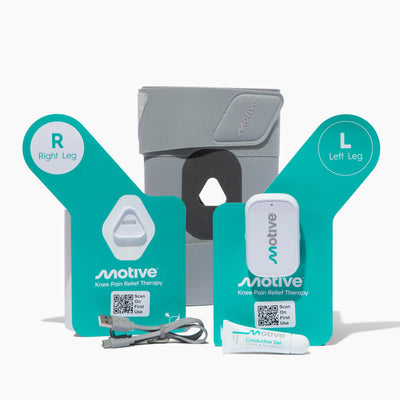
Undergoing knee surgery, such as knee replacement, ACL repair, or meniscus repair, is a critical step toward alleviating knee pain and enhancing mobility. Yet, the path to recovery requires a dedicated effort to rebuild knee strength and ensure long-lasting knee health.
In this article, we’ll explore both foundational and advanced strengthening exercises tailored to various stages of recovery, emphasizing the importance of starting with gentle movements and gradually increasing intensity.
Additionally, you'll learn how incorporating Motive’s targeted electrical stimulation therapy can accelerate your recovery by enhancing muscle strength and reducing recovery time.
Understanding Knee Rehabilitation
Rebuilding strength in the knee joint is crucial following surgery, not just for recovery but also to prevent future knee injuries. Rehabilitation often focuses on enhancing the flexibility and strength of muscles like the quadriceps and hamstrings, which play pivotal roles in knee stability and movement. Engaging with a physical therapist can provide personalized guidance on the best exercises and proper techniques to support the healing process.
To ensure optimal recovery, it is essential to incorporate exercises such as squats, lunges, and leg presses tailored to your recovery phase. Utilizing equipment like resistance bands and ankle weights can also help to intensify the exercises gradually, fostering stronger and more resilient knee joints.
Initial Steps in Knee Strength Rehabilitation
Embarking on knee strength rehabilitation post-surgery begins with foundational bodyweight exercises prescribed by healthcare professionals. These initial steps are critical in setting the stage for a successful recovery:
- Range of Motion Exercises: Gentle movements to regain mobility without overstressing the healing tissues.
- Hamstring and Quadriceps Stretching: Light stretching to maintain muscle elasticity and support the knee joint.
These activities lay the groundwork for enhanced healing and set a positive trajectory toward full knee recovery.
Advanced Exercises to Build Knee Strength
As your recovery progresses, integrating more advanced knee-strengthening exercises into your regimen is key to enhancing strength and flexibility. Here are some targeted activities to consider:
- Quadriceps Stretches and Strengthening: Straight leg raises and seated leg presses focus on rebuilding the front thigh muscles, crucial for supporting the kneecap and enhancing knee stability.
- Hamstring Curls and Calf Raises: These exercises strengthen the back of the thigh and calf muscles, respectively, balancing forces around the knee and improving overall joint support.
- Lunges and Squats: These exercises are performed at a slow pace with a focus on maintaining a 90-degree angle in the knee to avoid strain. Multiple repetitions of these exercises are fundamental for strengthening the glutes and quads.
-
Hip Abductor and Glute Strength: These exercises are are essential for strengthening the muscles to provide better support and stability to the knee.
This combination of exercises will significantly contribute to regaining and enhancing the strength and stability of your knee, promoting a more robust and sustained recovery.
Incorporating Motive Knee into Your Rehabilitation
Motive Knee elevates traditional physical therapy by providing targeted electrical stimulation therapy to the quadriceps, hamstrings, and surrounding muscle groups. This FDA-cleared device aids in rapidly increasing muscle strength, enhancing knee stability, and reducing the likelihood of recurring knee pain. Patients have reported significant improvements in knee strength and reduced discomfort with the integration of Motive Knee partnered with a strong exercise routine.
By directly targeting the muscles most crucial for knee support, Motive Knee ensures that each exercise session is more effective and tailored to your rehabilitation needs. Additionally, its ease of use and non-invasive nature make it a preferred choice for those seeking safe, long-term solutions for knee health recovery and maintenance.
Supportive Practices for Knee Strength
In addition to exercise, certain lifestyle changes can significantly enhance the strength and health of your knees. Below are dietary and ergonomic strategies to incorporate into your daily routine for optimal knee support:
- Dietary Recommendations: Include anti-inflammatory foods and supplements to nourish the body and aid muscle repair.
- Ergonomic Adjustments: Modify your daily activities to include low-impact exercises such as cycling and swimming, which maintain joint health without imposing excess stress. Ensure to warm up properly and use resistance bands or ankle weights for added strengthening.
These practices are crucial for creating a conducive environment for knee recovery and long-term health, enabling you to engage in daily activities with ease and less pain.
Protect and Enhance Your Knee Strength with Motive
Adopting a comprehensive approach to recovery, which includes a blend of carefully selected physical exercises, dietary adjustments, and cutting-edge solutions like Motive, can profoundly enhance your post-surgery outcomes. Embrace these strategies to ensure robust knee health so you can regain your mobility.
The transformative power of Motive Therapy can be achieved through a 90-day journey. Beginning with the activation of essential knee support muscles during the initial sessions, the therapy's effectiveness increases with regular use, tracked and facilitated by the Motive App. By day 30, significant improvements in knee function make daily activities more manageable and enjoyable. Continuing through the program, by day 60 and beyond, you will experience reduced pain, stiffness, and swelling, enabling fuller participation in life and return to activities you love.
For further insights on incorporating Motive Knee into your rehabilitation or to consult a healthcare professional about your specific needs, visit our website or contact your orthopedic specialist for medical advice.





